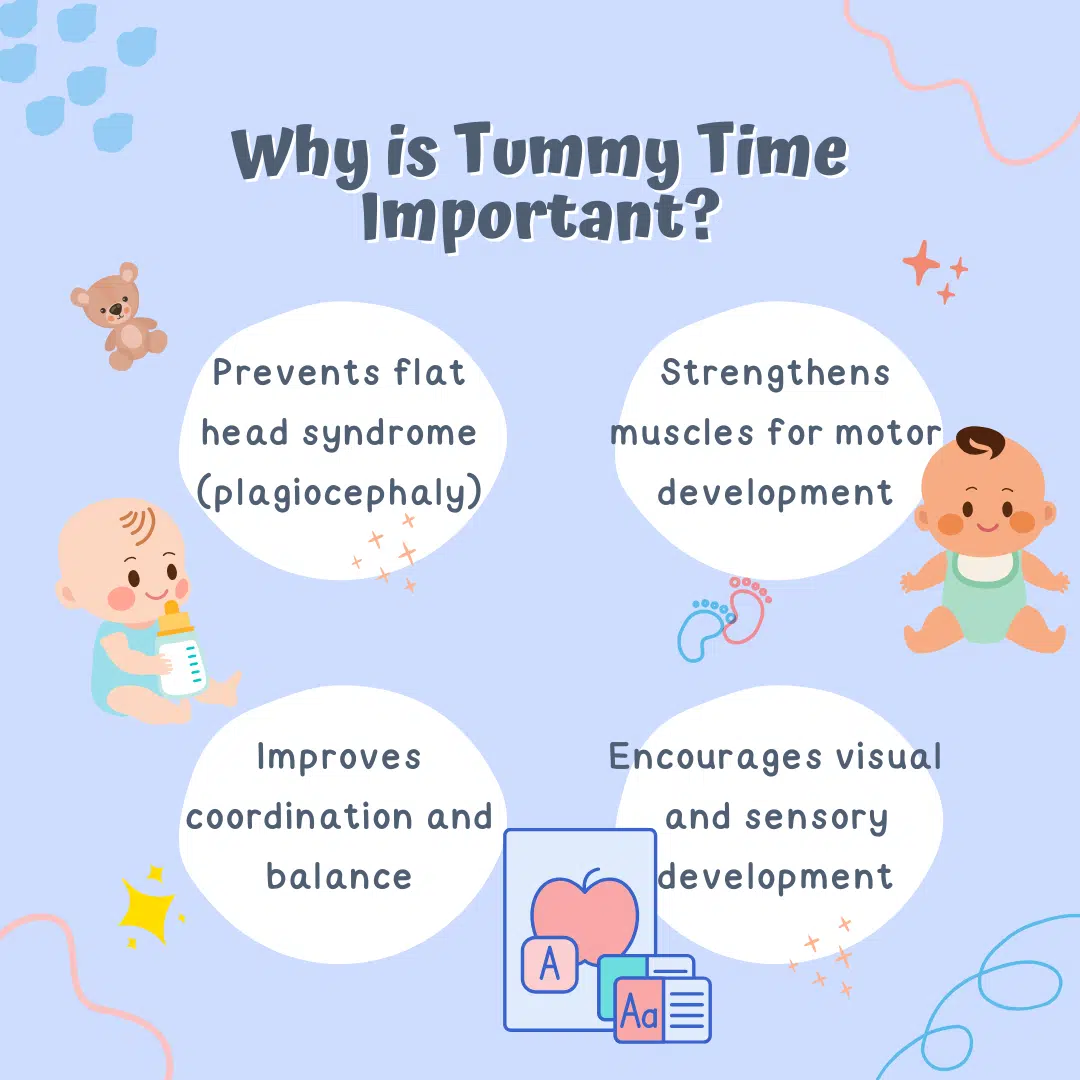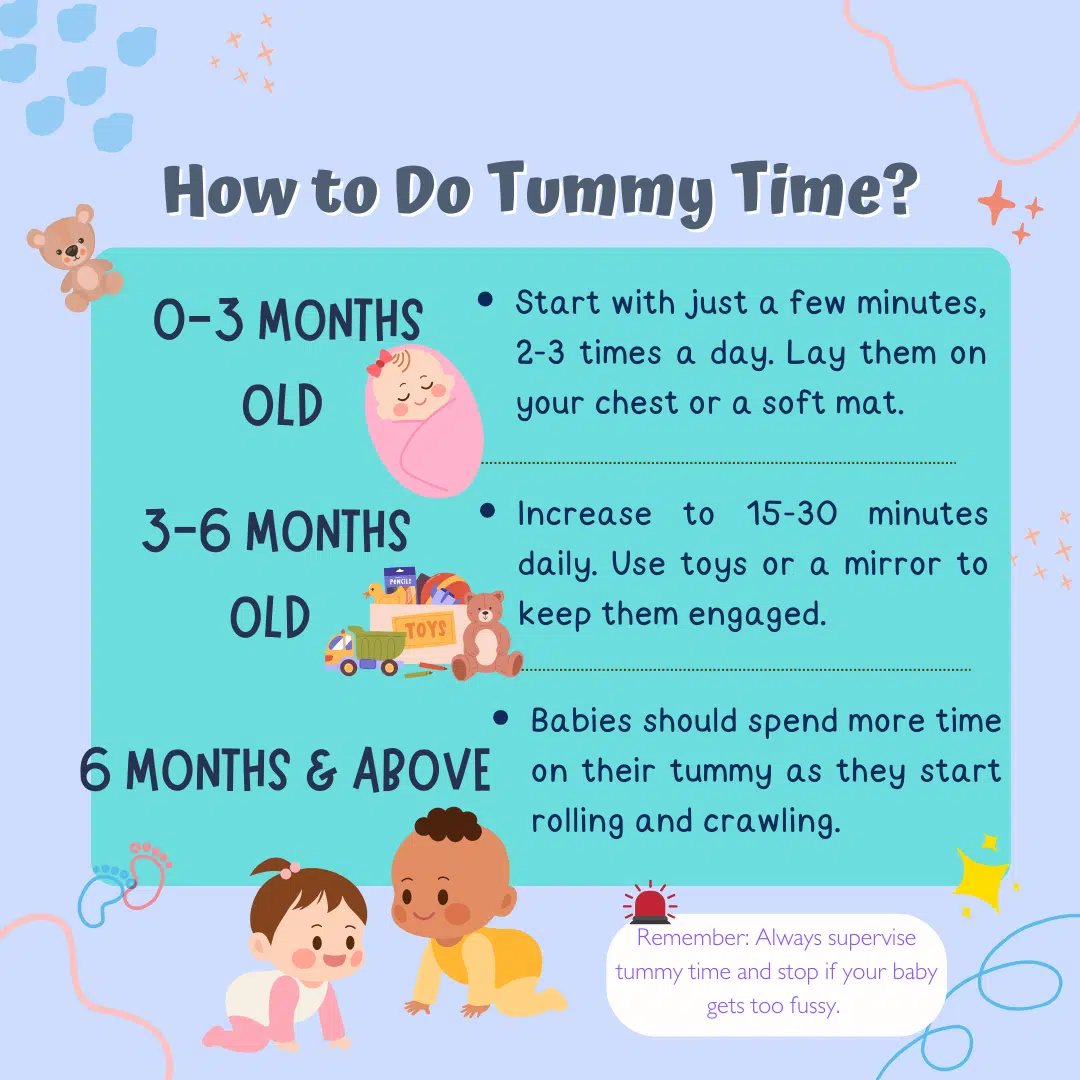
Tummy Time For Baby with Dr Soo
Tummy Time For Baby with Dr Soo
Tummy time is one of the most important activities for newborns and infants, playing a crucial role in their early development. It helps strengthen muscles, supports motor skills, and prevents conditions such as flat head syndrome. Many parents may wonder how to introduce tummy time and how to ensure their baby enjoys it. In this article, we will explore the benefits of tummy time and provide practical tips on how to do it effectively.
What Is Tummy Time? 🐥
Tummy time refers to the period when a baby is placed on their stomach while awake and supervised. This activity encourages them to lift their head, push up with their arms, and develop essential muscles needed for movement milestones like rolling, crawling, and sitting.
Since babies spend a lot of time lying on their backs while sleeping, tummy time provides a crucial counterbalance that strengthens their muscles and prevents certain conditions.
The Benefits of Tummy Time 🍼👶
Tummy time is not just a fun activity—it’s a necessary part of an infant’s growth and physical development. Here are some key benefits:
1. Strengthens Neck and Shoulder Muscles
When babies are on their tummy, they have to lift their heads, which strengthens their neck, shoulder, and upper back muscles. These muscles are essential for later milestones such as rolling over, sitting up, and crawling.
2. Prevents Flat Head Syndrome (Positional Plagiocephaly)

Babies spend a significant amount of time on their backs while sleeping, as recommended to reduce the risk of Sudden Infant Death Syndrome (SIDS). However, prolonged back-lying can lead to flat head syndrome, a condition where a baby’s skull becomes flattened. Tummy time helps to relieve this pressure and promotes a well-rounded head shape.
3. Encourages Motor Skill Development
Lying on their stomach allows babies to experiment with movement, helping them develop the strength and coordination needed for future mobility. It lays the foundation for rolling, crawling, and sitting.
4. Improves Sensory and Visual Development
Tummy time gives babies a new perspective on their surroundings. This encourages them to track objects with their eyes and enhances hand-eye coordination. Looking around from different angles also supports their spatial awareness.
5. Promotes Digestion and Reduces Gas
Tummy time can aid in digestion and help relieve gas or colic symptoms by applying gentle pressure to the abdomen. This position can also help babies pass gas more easily.
6. Prepares for Crawling and Other Milestones
Crawling is an essential part of a baby’s development, and tummy time helps babies get ready for it. By spending time on their stomach, babies develop the muscle coordination needed to push themselves up, move their arms and legs, and eventually start crawling.
7. Encourages Social Interaction
During tummy time, babies are often at eye level with caregivers, making it a great opportunity for bonding. Talking, singing, and engaging with your baby during tummy time helps with language development and social skills.
How to Do Tummy Time: Step-by-Step Guide
1. Start Early and Gradually Increase Time
-
Begin tummy time as early as the first few days after birth. Start with just 1-2 minutes, 2-3 times a day.
-
Gradually increase the duration as your baby gets stronger, aiming for a total of 30-60 minutes daily by the time they are 3-4 months old.
2. Choose the Right Time
-
Do tummy time when your baby is awake, alert, and in a good mood—avoid doing it right after a feeding to prevent spit-up.
-
A great time is after a diaper change or nap when they are refreshed.
3. Use a Comfortable Surface
-
Place your baby on a clean, firm surface, such as a play mat or a soft blanket on the floor.
-
Avoid placing them on soft surfaces like beds or sofas to prevent suffocation risks.
4. Engage with Your Baby
-
Get down to their level and talk, sing, or make funny faces to encourage them to lift their head and interact.
-
Place a mirror, colorful toys, or a book in front of them to capture their attention.
5. Use Different Positions
If your baby resists tummy time on the floor, try these alternatives:
-
Tummy-to-Chest: Lie back and place your baby on your chest. This allows them to practice lifting their head while feeling comforted by your presence.
-
Lap Tummy Time: Place your baby across your lap on their belly and gently rub their back.
-
Use a Tummy Time Pillow or Rolled-Up Towel: Placing a small pillow or rolled towel under their chest can help make tummy time more comfortable.
6. Encourage Movement
-
Help your baby push up by gently guiding their hands under their shoulders.
-
Roll a ball or move a toy slightly out of reach to encourage them to reach for it.
7. Keep It Fun and Positive
-
If your baby gets fussy, don’t force it. Try again later or shorten the session.
-
Always praise and encourage them for their efforts.
How to Handle Common Challenges
Baby Cries During Tummy Time
-
Start with very short sessions (even 30 seconds) and gradually increase as they get used to it.
-
Use distractions like toys, and songs, or place them on your chest for comfort.
Baby Falls Asleep on Their Stomach
-
Always supervise tummy time and never let your baby sleep in this position. If they fall asleep, gently turn them onto their back.
Baby Hates Tummy Time
-
Some babies resist tummy time, but consistency is key.
-
Try different locations, toys, or techniques like tummy-to-chest or using a tummy time pillow.
How Often Should You Do?
-
Newborns (0-1 month): Start with 1-2 minutes, 2-3 times a day.
-
1-3 months: Increase to 5-10 minutes per session, aiming for a total of 30 minutes daily.
-
3-6 months: Work up to 1 hour of tummy time spread throughout the day.
When to Stop
Tummy time is essential until your baby begins to roll over and move independently, usually around 6-7 months old. At this stage, they will naturally spend more time on their belly while playing.
Final Thoughts
Tummy time is a simple yet powerful activity that supports your baby’s development in numerous ways. By strengthening muscles, preventing flat head syndrome, and encouraging motor skills, tummy time lays the foundation for future milestones like crawling and sitting.
The key is to make it a fun and engaging experience for your baby. By starting early, keeping sessions short but consistent, and using creative techniques, you can help your baby enjoy tummy time and reap its many benefits.
So, grab a comfy mat, get down on the floor, and start tummy time today! Your little one will thank you with stronger muscles, better coordination, and a happy, healthy development journey.
Dr. Soo is a dedicated pediatrician with a passion for child health and wellness. With years of experience, Dr. Soo strives to educate parents on effective ways to improve their children’s health and well-being.




